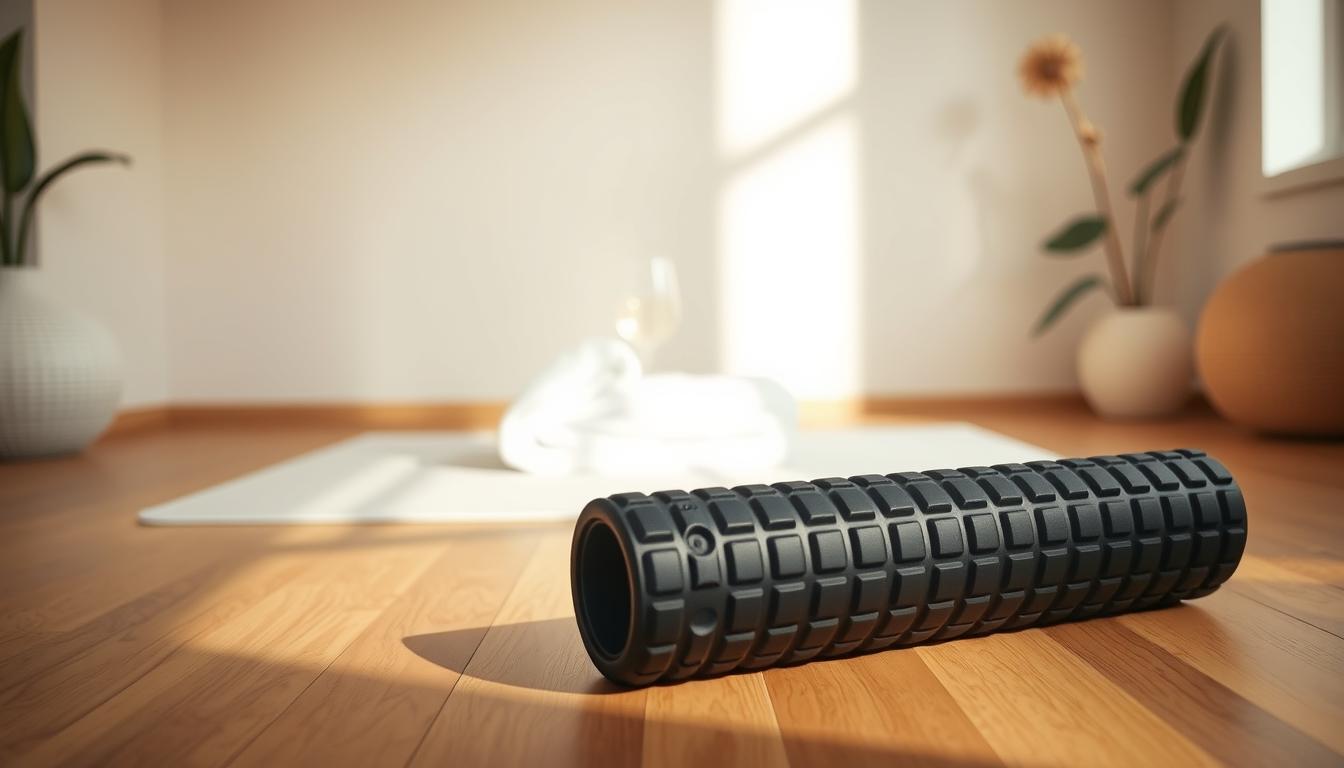In our fast-paced work life, spending long hours at a desk is common. This can cause discomfort. This guide offers upper trapezius stretches for office workers seeking relief from neck pain. These stretches are perfect.
Being seated all day can make our necks and shoulders tense. That’s why desk stretches are key. They help us stay well. These simple moves can make you more flexible and boost blood flow. This can lower the risk of muscle and joint issues.
Understanding the Trapezius Muscle
The trapezius muscle is a large, triangular muscle found in the upper back, extending to the neck. It is made up of three parts: upper, middle, and lower. Each part has a special job in moving the body and maintaining posture. Knowing how the trapezius works is key, especially for those who sit a lot during the day.
What are the Trapezius Muscles?
The trapezius muscles stretch from the skull’s base, across the shoulders, and down to the back’s middle. These muscles are crucial for many movements, like lifting the shoulders and moving them back. The upper part is especially important. It helps in shrugging, lifting arms, and keeping the shoulder blades stable.
Functions of the Upper Trapezius
The upper trapezius is vital for many everyday actions, including:
- Shoulder shrugging
- Arm lifting and reaching
- Head turning and tilting
It also helps hold up the head and neck. But, poor posture and staying tense can make these muscles very tight. This can lead to pain and make moving hard.
Common Issues Related to Tight Trapezius Muscles
Many people with desk jobs often have tight trapezius muscles. This can come from:
- Bad setup at their work station
- Stress and worry
- Doing the same movements over and over
These issues can cause pain or stiffness in the neck and back. It’s important to fix tight muscles to keep the trapezius working right and keep good posture.
The Impact of Sedentary Work on Muscle Health
Sedentary jobs are more common today, which isn’t good for our muscles. People sit too much at work, which can hurt their muscles. This mainly causes problems in the neck, shoulders, and lower back because of bad sitting positions.
Musculoskeletal Disorders in Desk Jobs
About 80% of workers in the U.S. spend their days sitting. This habit can cause serious muscle issues. To avoid such problems, it’s important to move around often.
Consequences of Poor Posture
Bad sitting positions can make muscle pain worse. Slouching or leaning too much can mess up your spine’s alignment. This adds stress to your body, leading to pain and less productive work days. Making small changes in how you sit and taking breaks can really help your health.
Why Stretching is Essential for Office Workers
For office workers, adding stretching to daily life is very important. It solves problems for people who sit a lot during the day. Doing stretches at work brings benefits for your body and mind.
Benefits of Stretching During Work Hours
Stretching when you’re working can help in many ways:
- Reduction of neck and shoulder tension
- Promotion of improved posture
- Enhanced blood circulation
- Decreased pain and discomfort
- Increase in productivity and mental clarity
How Stretching Affects Overall Well-being
Stretching not just helps reduce stress but also makes workspaces happier. When workers take time to stretch, they feel less stressed and more comfortable. This act makes the workplace better and more fun.
How to Do a Desk-Friendly Upper Trapezius Stretch
Doing a desk-friendly upper trapezius stretch is easy and you don’t need much space. Start by sitting straight and relaxing your shoulders. Gently tilt your head to one side, bringing your ear closer to your shoulder. Use your other hand to lightly push on the side of your head. This helps ease neck tension and makes you feel better.
Keep the stretch for 15 to 30 seconds to let your muscles relax. Then, do the same stretch on the other side. Doing these stretches during the day is a good way to fight the downsides of sitting too long. It’s a great habit to add to your daily desk-friendly stretch routine.
Simple Techniques for a Quick Stretch Break
Adding short stretch breaks into your day can boost your well-being and work output. Using the right upper trapezius stretch moves can ease tension, making desk work more pleasant. Below are some easy techniques for your break time.
Effective Upper Trapezius Stretch Techniques
- Shoulder Rolls: Gently roll your shoulders forward and backward to release built-up tension.
- Chin-to-Chest Movements: Lower your chin toward your chest and hold for a few seconds to stretch the neck area.
- Gentle Neck Tilts: Tilt your head towards one shoulder and hold. Alternate sides for an even stretch.
Timing Your Stretch Breaks Throughout the Day
For best results, take a few-minute stretch break every hour. Using apps and tools to remind you can help. For example, StretchClock can remind you to stand up and stretch, helping prevent soreness and strain. This organized method increases your energy and makes you feel better all day.
Additional Stretches to Complement Upper Trapezius Relief
Adding different stretches to your routine can make your upper back healthier. It also eases tension in the upper trapezius muscles. Trying various neck stretches and shoulder exercises can really help, especially if you sit at a desk all day.
Neck and Shoulder Stretches
Neck stretches can lessen tightness. Think about including these in your daily activities:
- Lateral neck tilts to stretch the sides of the neck.
- Shoulder rolls to release tension in the shoulder area.
- The ram’s horn stretch to open up the shoulders and neck.
Exercises for Upper Back Relief
For better upper back health, add these exercises to your breaks:
- Seated thoracic rotations to improve spinal mobility.
- Chest openers to correct the slouch from sitting too long.

Incorporating Stretching into Your Daily Routine
Adding daily stretching to your day makes you more productive and feel better. It’s important to stretch regularly, like every hour, on a schedule. This helps you move better and stay flexible. Taking short breaks to stretch reduces muscle tension and helps you focus better on your work.
Scheduling Stretch Breaks
A timetable for stretching makes it a regular part of your day. You can:
- Set alarms on your smartphone as a reminder to stretch.
- Use apps that remind you to stretch, so you won’t forget these breaks.
- Plan your stretches around your meetings or tasks to make it a habit.
Cues for Remembering to Stretch
Adding certain cues to your day helps you remember to stretch. Here are some tips:
- Combine stretching with daily activities like coffee breaks or changing tasks.
- Put post-it notes or desk signs up as reminders to stretch.
- Stretch with your coworkers to make it more fun and motivating.
Maintaining Proper Posture at Your Desk
Correct posture at the office is key to avoiding pain and staying well during long work hours. Simple ergonomic tips can make a big difference in improving your posture at a desk. The setup of your workstation and the tools you use affect how you sit. This can help you keep away from strain and keep your body aligned all day.
Posture Alignment Tips
To sit properly at a desk, keep these in mind:
- Ensure your monitor is at eye level to reduce neck strain.
- Keep your shoulders relaxed and back, avoiding slouching.
- Your feet should be flat on the ground or on a footrest to support your lower back.
- Use a chair that supports your lower back to maintain the natural curve of your spine.
How Technology Influences Posture
Technology affects our posture a lot, especially because we use screens so much. Staring at screens for too long often leads to a forward-head posture and spine issues. But, if you check your posture regularly, you can fight these problems. Using ergonomic chairs and adjustable desks can support your body the right way. Adding these ergonomic tips to your day can really improve how comfortable and productive you feel.
When to Seek Professional Help
Knowing when you have chronic tension and pain is key to keeping healthy in the long run. If you often feel discomfort in your neck, it could mean there’s a deeper problem that needs to be looked into. Keeping an eye on symptoms that show you may need help from a professional is crucial.
Signs of Chronic Tension and Pain
If you keep having neck tension, pay attention to these signs of chronic pain that might need professional help:
- Consistent discomfort not alleviated by stretching
- Limited range of motion in the neck and shoulders
- Frequent headaches accompanied by neck pain
Consulting a Physical Therapist
Seeing a physical therapist can be a big help if you’re dealing with ongoing tension. They make special treatment plans with exercises just for you, targeting muscle imbalances. Working with a therapist does more than just help you recover.
It can also highlight deeper problems causing your pain. This way, you can stop musculoskeletal disorders from getting worse and live a healthier life.
Creating a Healthy Workspace Environment
Having a healthy workspace is key to feeling good and being productive. Adding ergonomic furniture and setting up your desk the right way can boost comfort. This helps keep you healthy while working. Focusing on reducing strain creates a better work atmosphere and lowers the chance of getting hurt or feeling discomfort.
Ergonomic Furniture Options
Choosing good furniture is essential for a comfortable work area. Think about getting these:
- Adjustable chairs to support proper posture
- Sit-stand desks that allow for varied working positions
- Monitor stands to ensure screens are at eye level
- Footrests to promote optimal leg positioning
Desk Setup for Preventing Strain
Setting up your desk right can stop you from straining. When you arrange your workspace, make sure to:
- Keep your forearms level with the floor when you type
- Put the monitor at an eye-friendly distance
- Have tools and documents within easy reach
- Use keyboard trays for a comfortable wrist position
Conclusion
Adding upper trapezius stretches to your daily routine helps a lot, especially if you work at a desk. By doing these stretches often, you can fight neck pain effectively. This leads to better comfort and more productivity while working.
The benefits of trapezius stretches go beyond just easing muscle tension. They help you focus better and boosts your overall well-being.
It’s also key to sit properly and have a desk setup that’s good for your body. These practices pair well with stretching. Together, they make your work area a healthier place, keeping pain at bay.
Starting a regular stretching habit and paying attention to how you sit can make a big difference. These habits help lower pain and make your work area better for your health. Prioritize these actions every day to improve how you feel and work.



